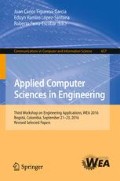Abstract
Given the current nature of electronic fraud prevention, there is a demand for high-quality and prompt customer service. These organizations must design well thought out strategies for improving customer service, especially with regard to reducing attention times, as any delays can lead to a higher level of fraud losses. With this in mind, organizations must develop a Shift- allocation proposal based on multiple criteria. The criteria must be validated through simulation techniques that permit optimizing two performance metrics: waiting times and costs.
Access this chapter
Tax calculation will be finalised at checkout
Purchases are for personal use only
References
Fernandez, J., Alonso, E.: Seguridad en informática. Aprocal Web (2003). http://www.aprocal.org.mx/
CESG: Good Practice Guide Transaction. National technical authority on information assurance. Guide No. 53 (2013)
Kasperski Lab.: 2014 desde la perspectiva viral en cifras en América Latina: predicciones para 2015. Kaspersky Web. http://latam.kaspersky.com/sobre-kaspersky/centro-de-prensa/blog-de-kaspersky/2014/analisis2014pronosticos2015LatAm
Jiang, L., Jun, M., Yang, Z.: Customer-perceived value and loyalty: how do key service quality dimensions matter in the context of B2C e-commerce. Serv. Bus. 10(2), 301–317 (2015)
Grönroos, C., Voima, P.: Critical service logic: making sense of value creation and co-creation. J. Acad. Mark. Sci. 41(2), 133–150 (2013)
Hansen, T., Wilke, R., Zaichkowsky, L.: How retailers handle complaint management. J. Consum. Satisfaction Dissatisfaction Complaining Behav. 22, 1–23 (2009)
Chan, H.C., Ngai, E.W.: What makes customers discontent with service providers? An empirical analysis of complaint handling in information and communication technology services. J. Bus. Ethics 91(1), 73–110 (2010)
Hanif, A., Khalid, W.: Customer service-a tool to improve Quality of Experience (QoE). In: 2012 IEEE Conference on Technology and Society in Asia (T&SA), pp 1–6 (2012)
Jäntti, M., Kalliokoski, J.: Identifying knowledge management challenges in a service desk: a case study. In: Second International Conference on Information, Process, and Knowledge Management, eKNOW 2010, pp 1–6 (2010)
Leonard, A., Strydom, I.: A conceptual framework for managing service desks: a South African perspective. In: 2011 Proceedings of PICMET 2011: Technology Management in the Energy Smart World (PICMET), pp 1–6 (2011)
Passmore, C.M., Zhan, J.: Determining appropriate staffing adjustments in a call center staff group. In: 2013 International Conference on Social Computing (SocialCom), pp 1–6 (2013)
Khan, S., Min-Allah, N.: A goal programming based energy efficient resource allocation in data centers. J. Supercomput. 61(3), 502–519 (2012)
Khan, S.: A multi-objective programming approach for resource allocation in data centers. In: International Conference on Parallel and Distributed Processing Techniques and Applications (PDPTA), pp 1–6 (2009)
Liao, S., Van Delft, C., Koole, G., Dallery, Y., Jouin, O.: Call center capacity allocation with random workload. In: International Conference on Computers & Industrial Engineering, CIE 2009, pp 1–6 (2009)
Punyateera, J., Leelasantitham, A., Kiattitsin, S., Muttitanon, W.: Study of service desk for NEdNet using incident management (service operation) of ITIL V.3. In: 2014 Asia-Pacific Signal and Information Processing Association Annual Summit and Conference (APSIPA), pp 1–6 (2014)
Andrade, R., Fuertes, W.: Diseño y dimensionamiento de un equipo de respuesta ante incidentes de seguridad informática (CSIRT). Repositorio Institucional de la Universidad de las Fuerzas Armadas ESPE (2013)
Acknowledgments
We would like to thank SOC Director Fernando Cuervo and Vice President of Operations Julian Arguelles for their help with sharing their information management processes at Easy Solutions, without which this project would not have been possible.
Author information
Authors and Affiliations
Corresponding author
Editor information
Editors and Affiliations
Rights and permissions
Copyright information
© 2016 Springer International Publishing AG
About this paper
Cite this paper
Méndez-Giraldo, G.A., Rodriguez-Garzón, N.D., Aranda-Rivera, P.C. (2016). A Simulation Model to Improve Customer Service in an Information Security Company. In: Figueroa-García, J., López-Santana, E., Ferro-Escobar, R. (eds) Applied Computer Sciences in Engineering. WEA 2016. Communications in Computer and Information Science, vol 657. Springer, Cham. https://doi.org/10.1007/978-3-319-50880-1_16
Download citation
DOI: https://doi.org/10.1007/978-3-319-50880-1_16
Published:
Publisher Name: Springer, Cham
Print ISBN: 978-3-319-50879-5
Online ISBN: 978-3-319-50880-1
eBook Packages: Computer ScienceComputer Science (R0)

